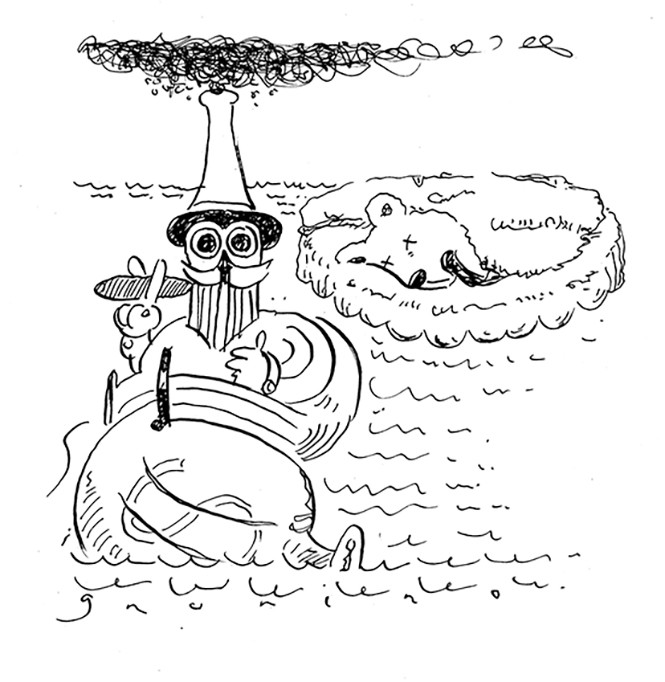So, the world is warming. How bad can we expect things to get? —Jeremy Ehrlich
Some say the world will end in fire, Jeremy, and some say in ice. I hold with those who say: Why choose? The ice, melting off the poles, will be what does us in, but only as a result of the great anthropogenic fossil-fuel inferno—a combo that wasn't on the menu of options Robert Frost had in mind. We discussed this stuff a few years back, when I noted that global warming seems to have forestalled any future ice age, perhaps indefinitely. That wasn't good news then, and the future doesn't look much rosier now. It does look wetter, however, according to a pileup of more recent studies on the sea-level problem.
Don't get me wrong: There are plenty of other ways climate change will wreck the planet, including in the places that'll escape the oceans—they'll merely have drought and general aridity to deal with, and all its knock-on effects. A study last year held climate change responsible for a doubling of wildfires in the American West over the last 30 years. Elsewhere, drought will mean new migration patterns and resultant strife—I'll point you toward convincing arguments that already we can assign some degree of responsibility for the Syrian civil conflict to rising global temps, the short version being that warming-induced drought pushed local farmers off their land and into cities, exacerbating preexisting social tensions. But if it's the worst-case scenario you're looking for, pal, then you're gazing into the deep blue sea.
And you're looking at, chiefly, Antarctica, whose disintegrating ice sheet could raise the global sea level 1 meter by 2100, and 15 meters by 2500—which would mean, as one researcher put it, "literally remapping how the planet looks from space." We're seeing the beginnings of this play out: more frequent nuisance flooding in places like Charleston, on the more benign end; on the other, existential crises in places like Kiribati, a tiny Pacific Island nation that's making plans to relocate wholesale before it finds itself underwater entirely.
The contemporaneous effects pale in comparison with what will happen on coasts, and particularly in coastal cities, if oceans rise to the extent of some projections. Sea levels just 2 meters higher will displace 2.5 million people from Miami, 1.8 million from Mumbai, more than a million each in New York and New Orleans, etc. We're already exacerbating this problem—i.e., in ways beyond our economic addiction to fossil fuels. More people are moving to coastal cities, leading to construction on land previously left undeveloped precisely because of flood risk. In some places, increased population can overtax the groundwater, causing cities to subside—literally sink as water is pumped from below. Sunny seaside Jakarta, with a metro area now home to 30 million, is expected to drop 6 feet by 2025—an inopportune development, one might say, what with oceans on their way up.
So: How likely is 1 meter of sea-level rise, let alone 15 meters? Here's where things get hazier, though I've got to say the outlook sucks. In its most recent assessment report, from 2014, the Intergovernmental Panel on Climate Change laid out four scenarios for greenhouse-gas buildup in the atmosphere, called representative concentration pathways. The rosiest assumes swift action to curtail GHG emissions, and an emissions peak between 2010 and 2020; two mid-level scenarios have emissions peaking sometime in the 21st century; and one scenario, called RCP 8.5, envisions no peak at all, just a continuing climb—the worst case.
"Currently, and despite implementation of climate mitigation in several regions, global greenhouse gas emissions are following the highest, RCP 8.5, emission trajectory," noted one cheery 2016 study describing the future of sea levels. Assuming we stay on the 8.5 track, the authors continue, average global sea levels should go up 0.9 meters by 2100, but again, that's just the average; certain regions, including Southeast Asia and the U.S. Atlantic coast, could see something more like the 2-meter increase described above. But what if we can get a hold on emissions by the end of the century? Another recent paper, in the journal Nature, raises the possibility we don't have that long: Continued high GHG levels in the next several decades alone could lead to an irreversible collapse of the Antarctic ice sheet, making that map-reconfiguring 15-meter rise an inevitability.
If there's a silver lining here, it's the overall uncertainty. These are, after all, projections, and researchers are only beginning to understand the highly complex system of the Antarctic ice sheet; a 2015 NASA study found that Antarctic snow accumulation has been enough to offset ice loss since the early '90s, though that likely won't last. The New York Times recently reported that U.S. and U.K. science foundations have initiated a big push to "get the data needed to refine the forecasts"—i.e., to figure how stable the ice sheet actually is, and what its future prospects are. But again, there's nothing to feel particularly sanguine about. How bad will things get? The fact that it's difficult to say is pretty icy comfort.
Send questions to via straightdope.com or write c/o Chicago Reader, 350 N. Orleans, Chicago 60654.
More by Cecil Adams
-
This Is the End, My Friend
This week's Straight Dope marks the last appearance of the column as the Teeming Millions have known it for the past 45 years.
- Jul 11, 2018
-
Do Brain Supplements Do Anything?
Brain Drain
- Jul 4, 2018
-
Is flying really worse for the environment than driving?
Planes and Trains
- Jun 27, 2018
- More »




